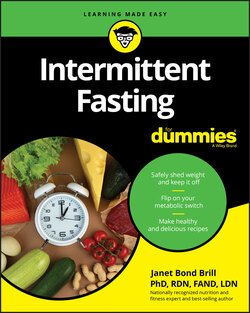Читать книгу Intermittent Fasting For Dummies - Janet Bond Brill - Страница 51
Following the 80:20 rule
ОглавлениеOne of the main reason diets fail is because people deprive themselves of the foods they love. When life happens, they go off the diet and gorge on those foods they restricted during the diet. Face it, if you love carbs, there’s no way that you’ll ever be able to not eat pasta for the next 50 years! The long-term solution and the gold standard of dietary balance and moderation is what nutritionists call the 80:20 rule.
The 80:20 rule, more formally called the Pareto principle, states that, for many events, roughly 80 percent of the effects come from 20 percent of the causes. If you apply this philosophy to your eating regime, you can use it as an approach to healthy eating. The 80:20 rule shows you the way to balance, moderation, and indulging without any feelings of guilt. Don’t let perfection be the enemy of the good.
The basic idea of the 80/20 rule as it applies to your intermittent fast is very simple. In order to be healthy and balanced, you don’t always have to make 100 percent healthy food choices. Eighty percent will do the trick. You can choose less healthy food and indulge yourself without guilt with the remaining 20 percent. Think of your 20 percent time as the freedom to eat the foods you love that may not be the healthiest. The 80/20 rule is a fantastic way to enjoy your treats and stay on the intermittent fasting train.
Your indulgences need to be a reasonable portion rather than a free-for-all eat fest. Just because your 20 percent is for treats doesn’t mean you can go rogue with the entire pint of ice cream.
Revisit Kiki again: She loves her red wine (she drinks one 8-ounce glass a night) and munches on her nighttime snacks. Kiki has zero intention of giving them up. She is following the 5:2 intermittent fast. On her five non-fasting days, she eats three healthy plant-based meals totaling approximately 1,400 calories. That leaves her with 450 treat calories for nighttime. If she makes her dog walking a daily routine, she gets to add an additional 100 calories to her treats stash or 550 calories per night during her five non-fasting days. Five hundred and fifty calories translate into 8 ounces of red wine (approximately 200 calories) plus an additional 350-calorie high volume, slow-eating snack such as a huge bowl of popcorn. No deprivation here!
Red wine in moderation is a heart-healthy habit. However, doctors advise against beginning to drink if you don’t already do so. Exercise caution with any alcohol consumption because alcohol carries with it the risk of overindulgence, with many negative health effects. According to the American Heart Association, moderate consumption is one to two drinks per day for men and one drink per day (5 fluid ounces) for women. If you have any doubts about whether it’s safe for you to consume wine or any type of alcohol, ask your personal physician.
